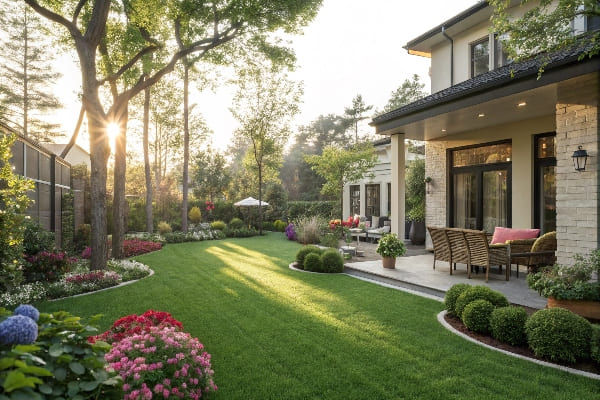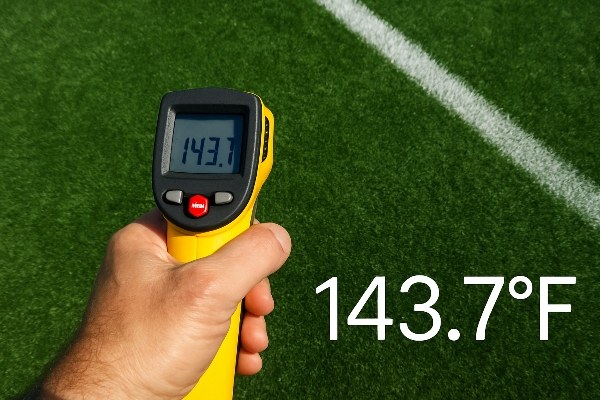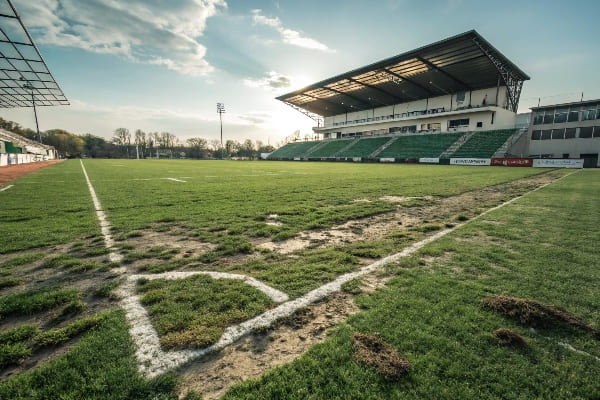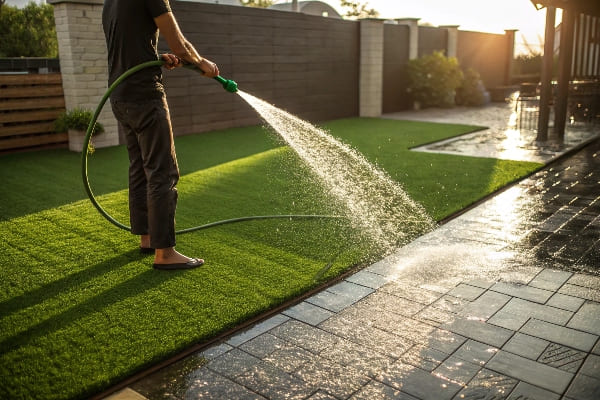Are you worried about your artificial grass investment wearing out too quickly? You don’t want a lawn that fades or flattens after a few years, forcing a costly replacement.
High-quality artificial turf can last from 8 to 15 years, while mid-range options last 5 to 8 years, and cheaper products last 3 to 5 years. The lifespan depends heavily on the material quality (Dtex), UV resistance, amount of foot traffic, and proper installation.

The lifespan numbers are a great starting point. But they don’t tell the whole story. As a turf engineer, I’ve seen firsthand what separates a lawn that lasts from one that fails. It’s not just about the product; it’s about understanding the potential downsides, knowing when to replace it, and what maintenance really looks like. Let’s look deeper into these questions so you can make a choice you’ll be happy with for years.
What are the negatives of artificial grass?
Artificial grass looks like a perfect, hassle-free solution. But you may have heard about some downsides, making you hesitate. Let’s look at the real negatives to help you decide.
The main negatives of artificial turf are the high upfront cost, the surface getting hot in direct sun, and environmental concerns about using plastic. Some people also simply miss the smell and feel of a natural lawn.

When customers like Mohammed, a business owner from Saudi Arabia, ask me about the downsides, I’m always direct. He needs to know everything before bidding on large projects. The negatives are real and need to be weighed against the benefits.
High Initial Cost1
The biggest hurdle is the upfront investment. It’s much more than seeding a natural lawn. You are not just paying for the turf itself. You also have to factor in the cost of preparing the ground base and the professional installation labor. While you save money in the long run on water and maintenance, the initial bill can be significant.
Heat on the Surface2
Artificial turf is typically made from polyethylene, which absorbs and holds heat from the sun. On a hot day, the surface can become very warm, sometimes too hot for bare feet or for pets to lie on comfortably. For projects in sunny climates like Mexico, I often recommend using lighter-colored turf or special cooling infills, which can help reduce the surface temperature.
Environmental Questions3
There’s no getting around it: artificial grass is a plastic product. This raises questions about its environmental impact, from manufacturing to disposal. While it saves enormous amounts of water and eliminates the need for pesticides and fertilizers, recycling old turf can be challenging. It’s an important trade-off to consider.
| Feature | Artificial Grass | Natural Grass |
|---|---|---|
| Upfront Cost | High | Low |
| Maintenance Cost | Very Low | High |
| Water Usage | None | High |
| Feel in Hot Sun | Can get very hot | Naturally cool |
| Durability | Long-lasting product | Needs constant care |
How often should artificial turf be replaced?
You have your turf, but how do you know when it’s time for a change? Replacing it too soon is a waste of money, but waiting too long makes your property look worn out.
You should replace artificial turf when you see clear signs of aging. This includes flattened fibers that won’t stand up, major color fading, frequent rips or seam separation, and a backing that is brittle or showing through the grass blades.

Knowing when to replace turf is key to managing long-term budgets, a major concern for my clients. The timing isn’t just about a date on a calendar; it’s about looking for specific signs of wear. The type of product you choose at the beginning directly impacts how soon you’ll see these signs.
Fiber Breakdown (Matting)4
Over time, especially in areas with a lot of foot traffic like walkways or sports fields, the grass blades will start to lie flat. This is called matting. At first, you can brush them back up. But as the turf ages, the fibers lose their resilience and will stay flat no matter how much you brush them. This is a sure sign the turf is at the end of its life. That’s why for sports use, I always recommend styles with a higher Dtex and better materials to ensure durability.
Color Fading from UV Rays5
Cheaper turf often lacks good UV-resistant materials. After a few years in the sun, it will start to fade. You might see the color change from a rich green to a pale, washed-out shade. Sometimes it can even look splotchy. For any outdoor use, especially in sunny places, choosing a product with added UV protection is critical. It costs more initially but extends the life and look of your lawn significantly.
Physical Damage and Seam Problems6
Small tears or lifting seams can be repaired. However, if your turf is old, the backing becomes brittle and repairs don’t hold well. If you find yourself constantly fixing rips, or if the seams are separating in multiple places, the turf has lost its structural integrity. It’s time to consider a complete replacement, as these issues can also become dangerous tripping hazards.
Is artificial turf hard to maintain?
You hear that artificial turf is "low-maintenance." But what does that really mean? You might worry about hidden tasks that will take up your time and effort. I can assure you it’s simple.
No, artificial turf is not hard to maintain. Regular maintenance involves simple tasks like rinsing it with a hose to remove dust and debris, and occasionally brushing high-traffic areas with a stiff broom to keep the fibers upright. It’s far less work than a natural lawn.

A big reason people switch to artificial turf is to get their weekends back. They are tired of mowing, watering, and weeding. As an engineer, I like to give a clear picture of what "low-maintenance" really involves. It’s not "no-maintenance," but it’s very close.
Regular Cleaning
The most common task is simply keeping the turf clean. This means using a leaf blower or a rake to remove leaves, twigs, and other organic debris. If it gets dusty or you have pets, a quick rinse with a garden hose will wash away dust, pollen, and pet urine. This simple step keeps your lawn looking fresh and clean.
Brushing the Fibers
In areas where people walk a lot, the grass blades can start to lean over. To fix this, you just need to brush them back up. Using a stiff, synthetic-bristle broom (never metal), brush against the natural grain of the turf. This is called "cross-brushing," and it helps the fibers stand tall again, keeping the lawn looking full and new. You may only need to do this a few times a year.
A Simple Maintenance Schedule
| Task | Frequency | Why It’s Important |
|---|---|---|
| Remove Debris | Weekly or as needed | Prevents organic matter from building up and keeps the lawn looking clean. |
| Rinse with Water | Monthly or as needed | Washes away dust, pollen, and pet residue, eliminating odors. |
| Cross-Brush Fibers | A few times per year | Lifts blades in high-traffic areas, maintaining a full, natural look. |
| Check for Weeds | Rarely (check edges) | Although rare, a few weeds might pop up at the edges. They are easy to pull. |
Compared to the constant work a natural lawn requires, these simple steps are incredibly easy. It’s why so many people, from homeowners to commercial property managers, find the switch to be a huge relief.
Conclusion
Choosing the right artificial turf is an investment in your property’s future. By understanding the factors that affect its lifespan and maintenance, you can select a product that offers lasting value.
-
Understanding the financial implications of artificial grass can help you make an informed decision about your investment. ↩
-
Exploring the effects of heat on artificial grass can guide you in choosing the right type for your climate and usage. ↩
-
Learning about the environmental impact of artificial grass can help you weigh its benefits against potential ecological drawbacks. ↩
-
Understanding fiber breakdown helps you recognize when your turf needs replacement, ensuring safety and aesthetics. ↩
-
Learn about UV fading to choose better turf options that last longer and maintain their vibrant appearance. ↩
-
Identifying these issues early can save you from costly repairs and enhance the longevity of your turf. ↩
_画板-1.png)
_画板-1.png)